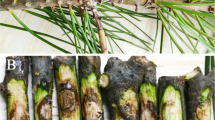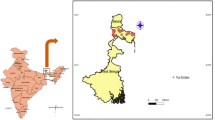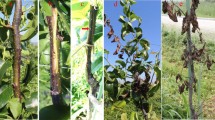Abstract
Papaver dubium (common name, blindeyes, Papaveraceae) is widespread throughout Europe and America and is an important weed in western Iran. Since 2009, a blight disease has occurred in several areas in Hamedan Province, Iran, causing significant damage to plants of P. dubium. Small, yellow–brown lesions appeared on lower leaves and eventually expanded to the whole plant, resulting in necrosis and complete wilting. This study was conducted to identify the causal agent(s) of the blight disease on blindeyes plants. On the basis of cultural and microscopic characters, as well as representative DNA sequence data of the 5.8S rRNA (ITS), partial LSU rRNA partial β-tubulin (TUB2), and partial G3PD genes, 82 isolates were identified as follows: Ascochyta pisi M. A. Libert. (42), Neodidymelliopsis longicolla L.W. Hou, Crous & L. Cai. (28), and Allophoma zantedeschiae (Dippen.) Q. Chen & L. Cai (12). Pathogenicity tests in the greenhouse showed that all the isolates of A. pisi and Neod. longicolla caused typical spots on inoculated blindeyes plants, and the fungi were successfully re-isolated from the symptomatic tissues. Based on the high isolation frequency for A. pisi, and the severity of symptoms induced by this species in pathogenicity tests, this fungus was indicated as the major pathogen causing the blight disease on blindeyes. It has potential as a biocontrol agent against P. dubium. To the best of our knowledge, Al. zantedeschiae and Neod. longicolla observed in this study are new taxa for the mycobiota of Iran.








Similar content being viewed by others
References
Abeln ECA, Stax AM, de Gruyter J, Van der AHA (2002) Genetic differentiation of Phoma exigua varieties by means of AFLP fingerprints. Mycol Res 106:419–427
Ahmadi AR, Muosavi SK, Ghiasvand M, Hasanvand A (2013) Investigation flora and distribution of weed species of field peas (Cicer arietinum L.) in Khorramabad. Intl J Farm Alli Sci 2:537–543
Aveskamp MM, de Gruyter J, Crous PW (2008) Biology and recent developments in the systematics of Phoma, a complex genus of major quarantine significance. Fungal Divers 31:1–18
Aveskamp MM, Verkley GJM, de Gruyter J, Murace MA, Perelló A, Woudenberg JHC, Groenewald JZ, Crous PW (2009) DNA phylogeny reveals polyphyly of Phoma section Peyronellaea and multiple taxonomic novelties. Mycologia 101:363–382
Aveskamp MM, de Gruyter J, Woudenberg JHC (2010) Highlights of the Didymellaceae: a polyphasic approach to characterise Phoma and related pleosporalean genera. Stud Mycol 65:1–60
Berbee ML, Pirseyedi M, Hubbard S (1999) Cochliobolus phylogenetics and the origin of known, highly virulent pathogens, inferred from ITS and glyceraldehyde-3- phosphate dehydrogenase gene sequences. Mycologia 91(6):964–977
Boerema GH (1993) Contributions towards a monograph of Phoma (Coelomycetes)—II. Section Peyronellaea. Persoonia 15:197–221
Boerema GH, de Gruyter J, Noordeloos ME (2004) Phoma identification manual. Differentiation of specific and infra-specific taxa in culture. CABI Publishing, Wallingford
Chen Q, Jiang JR, Zhang GZ, Cai L, Crous PW (2015) Resolving the Phoma enigma. Stud Mycol 82:137–217
Chen Q, Hou LW, Duan WJ, Crous PW, Cai L (2017) Didymellaceae revisited. Stud Mycol 87:105–159
Chilvers MI, Rogers JD, Dugan FM, Stewart JE, Chen W, Peever TL (2009) Didymella pisi sp. nov., the teleomorph of Ascochyta pisi. Mycol Res 113:391–400
Crous PW, Phillips AJL, Baxter AP (2000) Phytopathogenic fungi from South Africa. University of Stellenbosch, Stellenbosch, p 358
Cullen J (1966) Papaveraceae in Flora Iranica (ed. Rechinger KH). Graz Austria 34:1–25
Cullen DW, Toth IK, Boonham N, Walsh K, Barker I, Lees AK (2007) Development and validation of conventional and quantitative polymerase chain reaction assays for the detection of storage rot potato pathogens, Phytophthora erythroseptica, Pythium ultimum, Phoma foveata. J Phytopathol 155:309–315
De Gruyter J, Aveskamp MM, Woudenberg JHC, Verkley GJM, Groenewald JZ, Crous PW (2009) Molecular phylogeny of Phoma and allied anamorph genera: towards a reclassification of the Phoma complex. Mycol Res 133:508–519
De Gruyter J, Woudenberg JHC, Aveskamp MM, Verkley GJM, Groenewald JZ, Crous PW (2010) Systematic reappraisal of species in Phoma section paraphoma, pyrenochaeta and pleurophoma. Mycologia 102:1066–1081
De Gruyter J, Woudenberg JHC, Aveskamp MM, Verkley GJM, Groenewald JZ, Crous PW (2012) Rediposition of Phoma-like anamorphs in Pleosporales. Stud Mycol 75:1–36
Doidge EM (1950) The South African fungi and lichens to the end of 1945. Bothalia 5:1–1094
Goldblatt P (1974) Systematic studies in Papaver section oxytona. Ann Mo Bot Gard 61:264–298
Goodwin PH (2001) A molecular weed–mycoherbicide interaction: Colletotrichum gloeosporioides f. sp. malvae and round-leaved mallow, Malva pusilla. Can J Plant Pathol 23:28–35
Gorter GJMA (1977) Index of plant pathogens and the diseases they cause in cultivated plants in South Africa. Sci Bull 392:1–177
Gorter GJMA (1981) Index of plant pathogens (II) and the diseases they cause in wild growing plants in South Africa. Republic South Africa Department Agriculture Fish. Sci Bull 398:1–84
Mathew FM, Goswami RS, Markell SG, Osborne L, Tande C, Ruden B (2010) First Report of Ascochyta blight of field pea caused by Ascochyta pisi in South Dakota. Plant Dis 94(6):789
Melnik VA (2000) Key to the fungi of the genus Ascochyta Lib. (Coelomycetes). Mitt Biol Bundesanst Land- Forstwirtsch Vol 379, Biologische Bundesanstalt für Land- und Forstwirtschaft in Berlin und Braunschweig, Parey, Berlin
Melnik VA, Pystina KA (1995) Novitates de micromycetibus reservati Svirensis inferioris. Novosti Sist Nizsh Rast 30:29–36
Murray MG, Thomson WF (1980) Rapid isolation of high molecular weight plant DNA. Nucleic Acids Res 8:4321–4325
Nazer Kakhki SH, Minbashi Moeini M, Hassan Nejad S, Jafary H, Aleefard M (2013) Weed population incides in irrigated wheat fields of Zanjan province of Iran. Pakistan J Weed Sci Res 19:123–156
Orieux L, Felix S (1968) List of plant diseases in Mauritius. Phytopathological 7:1–48
Page RD (1996) TreeView: an application to display phylogenetic trees on personal computers. Comput Appl Biosci 12:357–358
Punithalingam E (1979) Graminicolous Ascochyta species. Mycol Papers 142:1–214
Punithalingam E, Holliday P (1972) Ascochyta pisi. CMI descriptions of pathogenic fungi and bacteria, no. 334. The Eastern Press Ltd., London
Rannala B, Yang Z (1996) Probability distribution of molecular evolutionary trees: a new method of phylogenetic inference. J Mol Evol 43:304–311
Rehner SA, Samuels GJ (1994) Taxonomy and phylogeny of Gliocladium analysed from nuclear large subunit ribosomal DNA sequences. Mycol Res 98:625–634
Richardson MJ (1990) An annotated list of seed-borne diseases. International Seed Testing Association, Zurich, p 387
Rodriguez F, Oliver JF, Marin A, Medina JR (1990) The general stochastic model of nucleotide substitutions. J Theor Biol 142:485–501
Ronquist FR, Huelsenbeck JP (2003) MrBayes3: Bayesian phylogenetic inference under mixed models. Bioinformatics 19:1572–1574
Ronquist FM, Teslenko M, van der Mark P, Ayres DL, Darling A, Höhna S, Larget B, Liu L, Suchard MA, Huelsenbeck JP (2012) MrBayes 3.2: efficient Bayesian phylogenetic inference and model choice across a large model space. Syst Biol 61:539–542
Sharma S, Kolte S (1994) Effect of soil-applied NPK fertilizers on severity of black spot disease (Alternaria brassicae) and yield of oilseed rape. Plant Soil 167:313–320
Swofford DL (2003) PAUP phylogenetic analysis using parsimony (and other methods). Version 4. Sinauer Associates, Sunderland
Tamura K, Stecher G, Peterson D, Filipski A, Kumar S (2013) MEGA6: molecular evolutionary genetics analysis version 6.0. Mol Biol Evol 30:2725–2729
Templeton GE, Smith Jr RJ (1977) In: Horsfall JG, Cowling EB (eds) Plant diseases: an advanced treatise. Academic Press, New York, pp 167–176
Thompson JD, Gibson TJ, Plewniak F, Jeanmougin F, Higgins DG (1997) The ClustalX windows interface: flexible strategies for multiple sequence alignment aided by quality analysis tools. Nucleic Acids Res 25:4876–4882
Vilgalys R, Hester M (1990) Rapid genetic identification and mapping of enzymatically amplified ribosomal DNA from several Cryptococcus species. J Bacteriol 172:4238–4246
White TJ, Bruns T, Lee S, Taylor J (1990) In: Innis A, Gelfand DH, Sninsky JJ (eds) PCR protocols. Academic Press, San Diego, pp 315–322
Acknowledgements
This research was funded by the Research Council of Bu-Ali Sina University, Hamedan, Iran. We would like to thank Dr Jafar Abdollahzadeh from the Faculty of Agriculture, University of Kurdistan, for facilitating the dissecting microscope with a digital camera.
Author information
Authors and Affiliations
Corresponding author
Ethics declarations
Conflict of interest
No conflict of interest declared.
Rights and permissions
About this article
Cite this article
Razaghi, P., Zafari, D. Characterization of fungi causing lesion blight on Papaver dubium in Iran. Antonie van Leeuwenhoek 111, 437–455 (2018). https://doi.org/10.1007/s10482-017-0966-8
Received:
Accepted:
Published:
Issue Date:
DOI: https://doi.org/10.1007/s10482-017-0966-8




